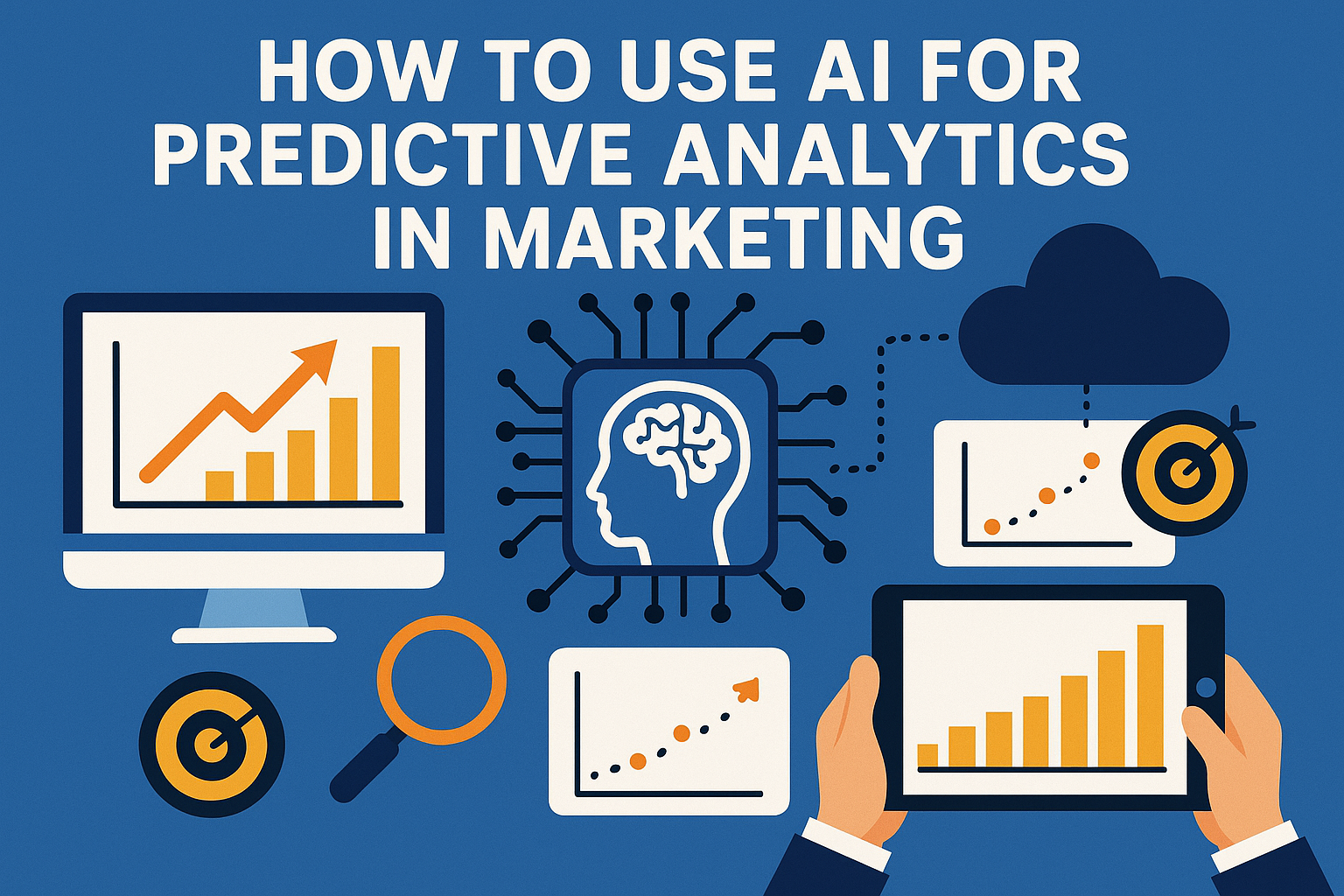
AI-powered predictive analytics is a game-changer for marketers, enabling data-driven strategies that anticipate customer behavior, optimize campaigns, and boost ROI. By analyzing historical data, AI predicts trends, preferences, and outcomes, helping businesses stay ahead. This guide explains how to use AI for predictive analytics in marketing, empowering you to make smarter decisions and drive growth.
Why Predictive Analytics Matters for Marketing in 2025
Predictive analytics uses AI to forecast customer actions, like purchases or churn, with up to 85% accuracy, per recent studies. This allows marketers to personalize campaigns, allocate budgets effectively, and increase conversions. Whether you’re a small business or a global brand, AI analytics can transform your marketing. Here’s how to implement it.
Step 1: Define Your Marketing Goals and Metrics
Clear objectives ensure AI delivers relevant predictions.
-
Set Specific Goals: Decide what to predict, such as “Which customers are likely to buy?” or “What’s the best time to send emails?”
-
Choose Key Metrics: Focus on metrics like customer lifetime value (CLV), conversion rates, or campaign engagement (click-through rates).
-
Identify Use Cases: Common applications include lead scoring, churn prevention, or ad performance forecasting.
Action Tip: Write down one marketing goal (e.g., “Increase email conversions by 15%”) and list 2-3 metrics to track with AI analytics.
Step 2: Select the Right AI Predictive Analytics Tools
Choose tools that align with your needs and technical skills.
-
Popular Tools:
-
HubSpot AI: Integrates predictive lead scoring and campaign insights with CRM, ideal for small businesses.
-
Salesforce Einstein: Offers advanced forecasting for customer behavior, suited for enterprises.
-
Google Analytics 4 (GA4): Free AI-driven predictions for web and app engagement, great for beginners.
-
RapidMiner: No-code platform for custom predictive models, perfect for data-savvy marketers.
-
-
Free vs. Paid: GA4 is free; HubSpot starts at $50/month, and Salesforce at $25/user/month.
-
Integration: Ensure tools connect with your marketing stack (e.g., CRM, email platforms) for seamless data flow.
Action Tip: Sign up for GA4 or try a 14-day trial of HubSpot AI to explore predictive features for your campaigns.
Step 3: Collect and Prepare Quality Data
Accurate predictions depend on clean, comprehensive data.
-
Gather Relevant Data: Pull data from CRM (e.g., Salesforce), email platforms (e.g., Mailchimp), or social media analytics (e.g., Instagram Insights).
-
Clean Data: Use AI tools to remove duplicates, fill missing values, or standardize formats. For example, HubSpot AI can auto-clean customer records.
-
Enrich Data: Add external data, like demographic or purchase history, to improve prediction accuracy.
Action Tip: Import one dataset (e.g., email campaign data) into your chosen tool and use its AI cleaning features to prepare it for analysis.
Step 4: Build and Run Predictive Models
AI tools simplify creating models to forecast outcomes.
-
Use Pre-Built Models: Tools like Salesforce Einstein offer ready-to-use models for lead scoring or churn prediction, requiring no coding.
-
Customize Models: For advanced users, RapidMiner lets you build tailored models to predict specific outcomes, like ad click probability.
-
Test Predictions: Run the model on a small dataset to validate accuracy, such as predicting which leads convert based on past campaigns.
Action Tip: Use a tool like GA4 to run a pre-built predictive model (e.g., purchase probability) on your website data and review the results.
Step 5: Act on Insights and Optimize Campaigns
Turn predictions into actionable marketing strategies.
-
Personalize Campaigns: Use AI insights to target high-value leads with tailored emails or ads. For example, send discounts to customers predicted to churn.
-
Optimize Budgets: Allocate ad spend to channels or audiences with the highest predicted ROI, as identified by tools like HubSpot.
-
Monitor and Refine: Track campaign performance (e.g., conversions) and adjust strategies monthly based on new AI predictions.
Action Tip: Apply one AI prediction (e.g., target high-value leads) to your next campaign and measure its impact on conversions after two weeks.
Bonus Tips for Predictive Analytics in 2025
-
Leverage AI Assistants: Use tools like xAI’s Grok (visit x.ai/api for details) to interpret complex analytics or suggest campaign tweaks.
-
Stay Trend-Aware: Follow marketing trends on X or LinkedIn to adopt new AI analytics features early.
-
Combine Tools: Pair GA4 for web insights with HubSpot for CRM predictions to cover all marketing angles.
Common Mistakes to Avoid
-
Poor Data Quality: Inaccurate or incomplete data leads to faulty predictions. Always clean data first.
-
Overcomplicating Models: Start with pre-built models to avoid overwhelming your team.
-
Ignoring Results: Failing to act on predictions wastes potential. Implement insights promptly.
Conclusion
Using AI for predictive analytics in marketing in 2025 can supercharge your campaigns and drive better results. By defining goals, selecting the right tools, preparing data, building models, and acting on insights, you can stay ahead of the competition. Start small—choose one AI tool and run a predictive analysis for your next campaign today.
Ready to boost your marketing with AI? Sign up for a tool like GA4 or HubSpot and start predicting success now!